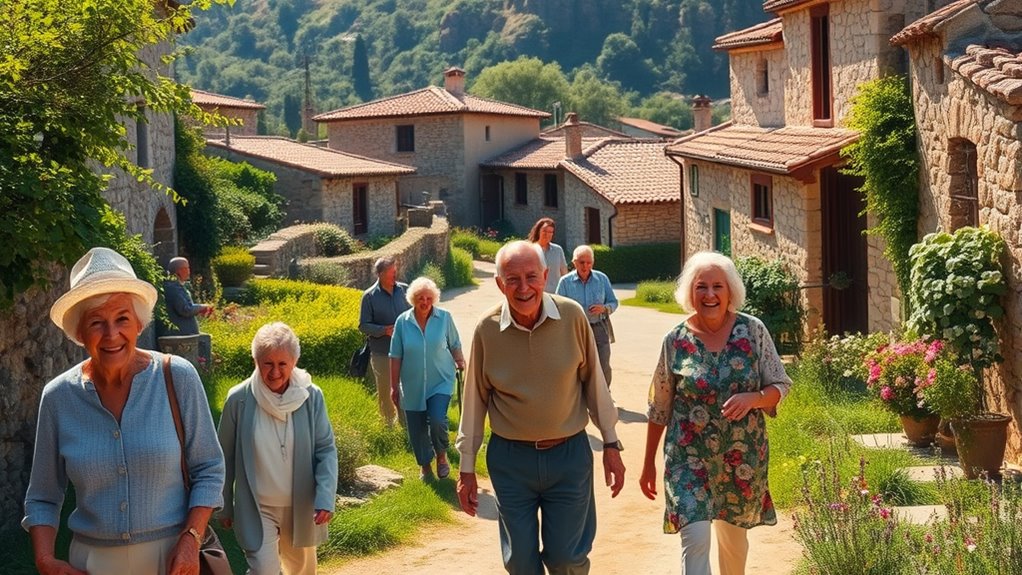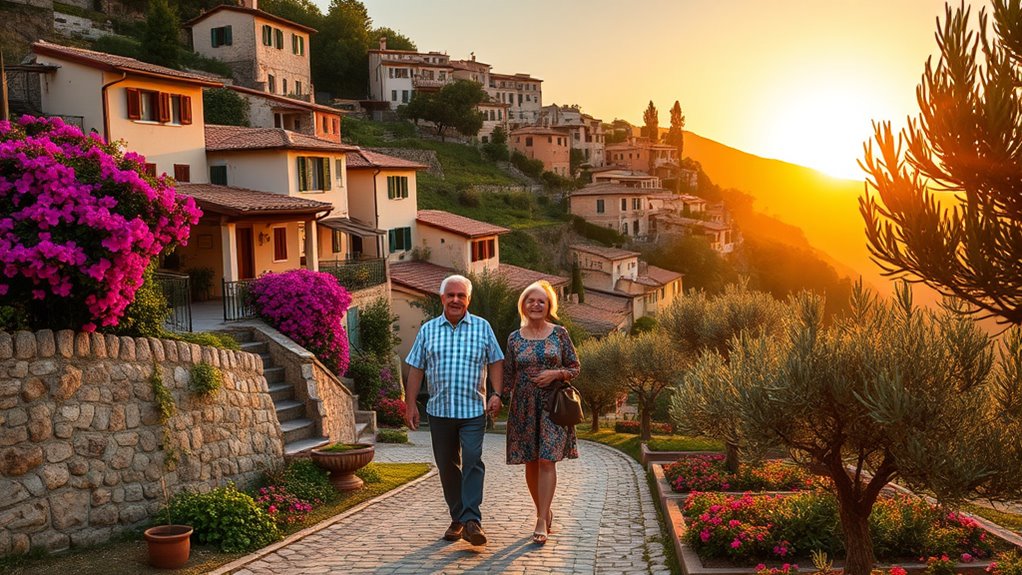Blue Zones teach us that longevity depends on lifestyle choices, strong social bonds, and supportive environments. Focus on eating mostly plant-based foods, whole grains, and nuts while avoiding processed foods and excess sugar. Engage regularly with family and community, sharing meals and activities that foster connection. Prioritizing both physical health and emotional well-being creates a balanced life. If you want to discover how these habits can help you live longer and better, keep exploring these inspiring lessons.
Key Takeaways
- Blue Zones are regions where people live significantly longer, healthier lives due to environmental, dietary, and social factors.
- A plant-based, whole foods diet with moderate protein intake supports longevity in Blue Zone communities.
- Strong social connections and community engagement are vital for mental and emotional well-being among long-lived populations.
- Sharing meals and social activities reinforce bonds, reduce stress, and promote healthier lifestyles.
- Adopting routines that combine healthy eating and social involvement can enhance lifespan and overall quality of life.

Many of the world’s longest-lived people reside in regions known as Blue Zones, where extraordinary longevity is the norm. If you want to understand what sets these communities apart, focusing on their dietary habits and community engagement provides valuable insights. These areas aren’t just about eating well; they’re about creating environments that promote health, purpose, and connection. As you explore these zones, you’ll notice that their diets emphasize plant-based foods, whole grains, and moderate protein intake, often from beans and nuts. They tend to avoid processed foods, excess sugar, and refined carbs, which helps reduce inflammation and chronic disease risk. This consistent pattern of mindful eating not only nourishes the body but also fosters a sense of routine and restraint that contributes to longevity.
Community engagement plays an equally essential role in these regions. The long-lived individuals are deeply embedded in social networks—whether through family, faith, or community groups. You’ll see that staying socially active isn’t just a matter of companionship; it’s a crucial part of aging well. Regular interactions with friends and neighbors provide emotional support, reduce stress, and give life a sense of purpose. These communities often organize group activities—like shared meals, walking clubs, or volunteer work—that encourage connection and physical movement. In these environments, aging isn’t viewed as decline but as an ongoing opportunity for involvement and contribution. Additionally, the social interactions often include shared meals, which help reinforce bonds and emotional stability.
In Blue Zones, diet and social life are intertwined. Eating together isn’t just about nutrition; it’s about strengthening bonds and fostering a sense of belonging. You’ll observe that meals are often shared with family or community members, reinforcing social ties and providing emotional stability. This combination of healthy dietary habits and active community engagement creates a feedback loop that promotes physical health and mental well-being. When you adopt some of these practices—like prioritizing plant-based eating and staying socially connected—you tap into a powerful formula for longevity.
These lessons from Blue Zones aren’t about rigid rules but about cultivating a balanced lifestyle that nurtures both body and soul. Embracing a diet rooted in whole foods and fostering meaningful social connections can profoundly impact your health and lifespan. As you incorporate these principles into your daily life, you align yourself with the habits of the world’s longest-lived people, giving yourself a better chance at living not just longer, but better.
Frequently Asked Questions
How Do Blue Zone Diets Vary Across Different Regions?
You’ll notice that Blue Zone diets differ across regions, but they share common traits like plant-based diets and traditional cooking methods. In some areas, people focus on legumes, vegetables, and whole grains, while others incorporate more fish or dairy. Despite regional differences, these diets emphasize natural, minimally processed foods, showcasing how traditional cooking techniques support longevity. Adapting these practices can help you improve your health and well-being.
What Role Does Genetics Play in Blue Zone Longevity?
Imagine a garden where some plants thrive naturally. Genetic predisposition and hereditary factors influence longevity, but they aren’t the whole story. In Blue Zones, your genes may give you a head start, but lifestyle choices like diet, activity, and community play crucial roles. Think of genetics as the seed, while your daily habits nurture the plant’s growth, ultimately shaping your lifespan.
Are Blue Zone Lifestyle Habits Applicable Worldwide?
You might wonder if blue zone lifestyle habits work everywhere. Cultural influences shape daily routines, diets, and social connections, making these habits adaptable in different settings. Environmental factors like access to healthy foods and walkable communities also matter. While not every practice fits perfectly everywhere, adopting core principles like active living and strong social ties can boost longevity worldwide. So, yes, these habits can be tailored to suit diverse cultures and environments.
How Do Blue Zones Handle Healthcare and Medical Access?
Imagine a world where healthcare is more like a vintage radio—simple, accessible, and community-centered. In Blue Zones, locals prioritize preventive care and community health, making medical access seamless and affordable. They focus on early intervention and strong local networks, reducing reliance on high-tech solutions. This approach fosters longevity and well-being, proving that accessible, community-driven healthcare is key to healthier, longer lives worldwide.
Can Urban Environments Support Blue Zone Lifestyle Practices?
Urban environments can support Blue Zone lifestyle practices through thoughtful urban planning and active community engagement. By creating walkable neighborhoods, accessible green spaces, and promoting local markets, you encourage healthy habits. When communities stay connected and engaged, they foster social bonds essential to longevity. Your involvement in local initiatives helps make sustainable changes that support Blue Zone principles, turning cities into vibrant places where long, healthy lives are more achievable for everyone.
Conclusion
So, as you glimpse into the secrets of the Blue Zones, you realize it’s not just about what these communities do differently—it’s about what you could start doing today. The habits that contribute to their longevity hold the potential to transform your life. But will you take the first step toward a longer, healthier future? The choice is yours, and the clock is ticking—what’s stopping you from accessing your own Blue Zone?









